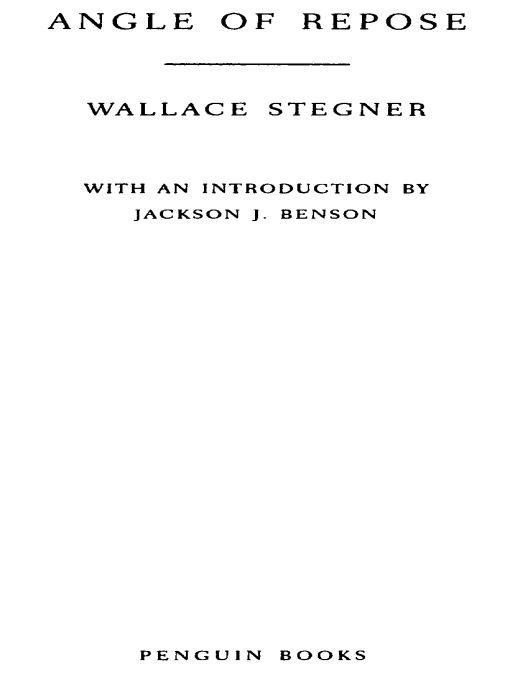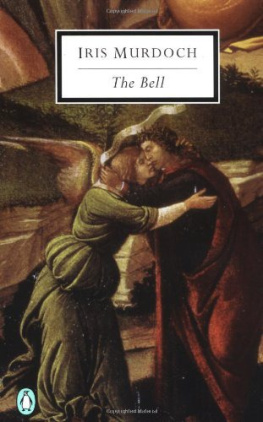Table of Contents
PENGUIN CLASSICS ANGLE OF REPOSE
CLASSICS ANGLE OF REPOSE Wallace Stegner ( 1909-1993) was the author of, among other novels, Remembering Laughter, 1937; The Big Rock Candy Mountain, 1943; Joe Hill, 1950; All the Little Live Things, 1967 (Commonwealth Club Gold Medal); A Shooting Star, 1961; Angle of Repose, 1971 (Pulitzer Prize); The Spectator Bird, 1976 (National Book Award, 1977); Recapitulation, 1979; and Crossing to Safety, 1987. His nonfiction includes Beyond the Hundredth Meridian, 1954; Wolf Willow, 1963; The Sound of Mountain Water (essays), 1969; The Uneasy Chair: A Biography of Bernard DeVoto, 1974; and Where the Bluebird Sings to the Lemonade Springs: Living and Writing in the West (1992). Three of his short stories have won O. Henry Prizes, and in 1980 he received the Robert Kirsch Award from the Los Angeles Times for his lifetime literary achievements. His Collected Stories was published in 1990.
Jackson J. Benson was born and raised in San Francisco, graduated from Stanford, and received his M.A. from San Francisco State University and his Ph.D. from the University of Southern California. From 1966 to 1997 he served as professor of English and comparative literature at San Diego State University, where he taught twentieth-century American literature. Twice a fellow of the National Endowment of the Humanities, he has published eleven books on modern American literature. Among them is the authorized biography The True Adventures of John Steinbeck, Writer (1984), which won the PEN West USA award for nonfiction. His latest work was the authorized biography Wallace Stegner: His Life and Work (1996), which won the David Woolley and Beatrice Cannon Evans Biography Award.
To request Penguin Readers Guides by mail
(while supplies last), please call (800) 778-6425
or e-mail reading@us.penguingroup.com.
To access Penguin Readers Guides online,
visit our Web site at www.penguin.com.
For my son, Page.
My thanks to J.M. and her sister for the loan of their ancestors. Though I have used many details of their lives and characters, I have not hesitated to warp both personalities and events to fictional needs. This is a novel which utilizes selected facts from their real lives. It is in no sense a family history.
INTRODUCTION
Angle of Repose is Wallace Stegners masterpiece, the crown jewel in a multifaceted writing career. From the time he finished his Ph.D. in 1935 to his death in 1993, he published some fifty-eight short stories, a dozen novels, two histories, two biographies, a memoir-history, and five collections of essays. He was given numerous awards for his writings, including the Pulitzer Prize for Angle of Repose, the National Book Award for The Spectator Bird, and the Lifetime Achievement Award by the LosAngeles Times.
From the early 1950s, he became as well known for his environmental activities and writings as for his fiction. However, it was the writing of novels that was closest to his heart, and it was as a novelist that he wanted to be remembered. In a recent poll of readers of the San Francisco Chronicle voting on the best one hundred novels written about the West, Angle of Repose was listed number one. Often mentioned by critics as one of the most important American novels of the twentieth century, it alone should ensure Stegners reputation. (In a Chronicle poll of best nonfiction books, his John Wesley Powell biography, Beyond the Hundredth Meridian, was listed number two.)
Wallace Stegners life almost spanned the twentieth century, from the last homestead frontier in Saskatchewan to the information age in Silicon Valley, from horse and plow to mouse and computer. The major strands of his careerhis love of the land, his concern for history, his advocacy of cooperation and antagonism toward rugged individualismand his dedication to writing can be clearly seen as products of his early life. He was born in Iowa in 1909, the younger of two sons, but the family soon moved to North Dakota, to Washington State, and then to Eastend, Saskatchewan. His father, George Stegner, was what his son later called a boomer, a man looking to find a fortune in the West and who, not finding it in one place, went to another. His mother was what Wallace called a nester. She wanted nothing more than a home of her own in which to raise a family.
Wallaces accounts of his growing up make it clear that a dichotomy developed early in his consciousness between the proud, tough, intolerant rugged individualism represented by his father and the friendly, tolerant, neighborly tendencies toward caring and cooperation represented by his mother. And as we can see throughout his writing, Wallaces sympathies lay with his mother and the values she represented. Although like her husband his mother never went beyond the eighth grade in school, she loved books and passed on a love of reading to her son.
Together his parents would seem to have been the archetypal western couple. In later years, as a writer, Wallace saw them as representing the exploiter, on the one hand, and the civilizer on the other. Although they are quite different in character and background, we can see Oliver and Susan Ward in their roles in
Angle of Repose as dim reflections of Stegners parents. (Certainly Wallaces deep love and respect for his mother contributed to his ability to create such complex and sympathetic women characters as Susan Burling Ward.) When asked by an interviewer if the life of Mary Hallock Foote, the model for the heroine of
Angle of Repose, had reminded him of the life of Elsa Mason, the mother in the semiautobiographical
The Big Rock Candy Mountain, Stegner said,
Not consciously. It never occurred to me that there was any relation between Angle of Repose and Big Rock Candy Mountain till after I had finished writing it. Then I saw that there were all kinds of connections. There was the wandering husband and the nesting woman, and the whole business reproduced in many ways in somewhat more cultivated terms and in different places what The Big Rock Candy Mountain was about. Its perfectly clear that if every writer is born to write one story, thats my story.
Two periods in his growing up had a major influence on forming his outlook and interests. The first was his six years in childhood spent in the village of Eastend and every summer on the homestead farm in Saskatchewan near the Montana border. After the first year, his older brother, Cecil, got a summer job at the grocery store in town, and so Wallace was alone with his parents, out on the hot prairie, living in a tarpaper shack. It was a place with searing wind, scorching sky, tormented and heat-warped light, and not a tree. Yet, amazingly enough considering such a barren and hostile environment, he could still look back on a childhood not of suffering and boredom, but of wild freedom, a closeness to earth and weather, a familiarity with both tame and wild animals. His summers on the homestead and winters in the frontier village during his most impressionable years marked him, as he has said, a westerner for life. And they would eventually produce a writer determined to represent the western experience as it really was, and the relationship of its people to the land as it was, is, and should be.


 CLASSICS ANGLE OF REPOSE
CLASSICS ANGLE OF REPOSE





